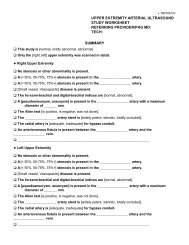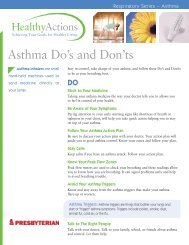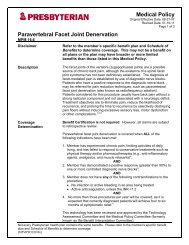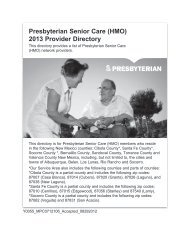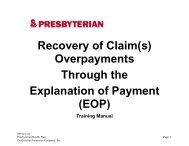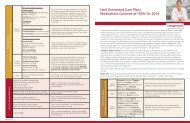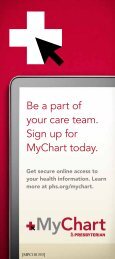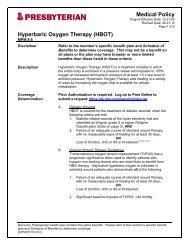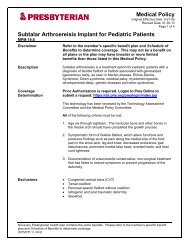2013 Practitioner and Provider Manual - Presbyterian Healthcare ...
2013 Practitioner and Provider Manual - Presbyterian Healthcare ...
2013 Practitioner and Provider Manual - Presbyterian Healthcare ...
You also want an ePaper? Increase the reach of your titles
YUMPU automatically turns print PDFs into web optimized ePapers that Google loves.
Long-Term Carephysical health, behavioral health, <strong>and</strong> longtermcare providers (a list of policies <strong>and</strong>procedures is available athttps://www.phs.org/providers/cliniciansresources/)Data exchange <strong>and</strong> access to clinicalinformation across systems of care throughtechnology solutions that include• <strong>Presbyterian</strong>’s web-based caremanagement platform, where providerscan access data regarding claims,authorizations, member risk stratification,<strong>and</strong> care coordination• Community Connect, an external providerEpic tool for smaller providers withouttheir own electronic health records (EHRs)• Data interfaces with providers’ existingEHRs <strong>and</strong> our care management platform• Data dashboards with actionable memberinformation that allows providers tomonitor members’ outcomes <strong>and</strong> theirperformance against specific st<strong>and</strong>ardsCare Coordination<strong>Presbyterian</strong>’s member-centric care model isdesigned to integrate physical health, behavioralhealth, <strong>and</strong> long-term care services into a seamlesscare system that provides members withappropriate services at the right time within theleast restrictive <strong>and</strong> most cost-effective setting. Ourlong-term care providers play a key role in thisprocess by engaging members, participating in careplanning efforts, <strong>and</strong> ensuring comprehensive,coordinated, <strong>and</strong> culturally appropriate care foreach unique member. The care model promotescollaboration <strong>and</strong> supports providers in advancingwellness <strong>and</strong> promoting independence, resiliency,healthy living, health literacy, <strong>and</strong> personalresponsibility. A comprehensive underst<strong>and</strong>ing ofthis model by our providers is critical. The followingsubsections describe our care model’s corecomponents.Risk Stratification <strong>and</strong> Comprehensive NeedsAssessmentAll members receive a Health Risk Assessment(HRA), are assigned to a level of care coordination,<strong>and</strong> are partnered with a dedicated carecoordinator. Members are matched with anappropriate care coordinator based on their clinicalneeds, geography, language, cultural preferences,<strong>and</strong> history of established relationships with aprovider or community-based service agency. AllLevel 2 <strong>and</strong> Level 3 members receive an in-personCNA to identify <strong>and</strong> prioritize their clinical,behavioral, functional, <strong>and</strong> social support needs.Interdisciplinary Care Plan TeamBased on the results of the CNA, an individualizedcare plan is developed for each member <strong>and</strong> anappropriate ICPT is established. The ICPT includesthe member <strong>and</strong> all providers, including PCPs,specialists, <strong>and</strong> support providers, along with anyadditional resources needed to fulfill the care plan’sgoals, such as a behavioral health provider <strong>and</strong>/orpharmacist. The care plan is reviewed, approved,<strong>and</strong> signed by the member. The ICPT is structuredto address the member’s specific needs <strong>and</strong> is acentral component of the care model. Members areencouraged to actively participate in the care10-92014 <strong>Practitioner</strong> <strong>and</strong> <strong>Provider</strong> <strong>Manual</strong> - Ver. 3



